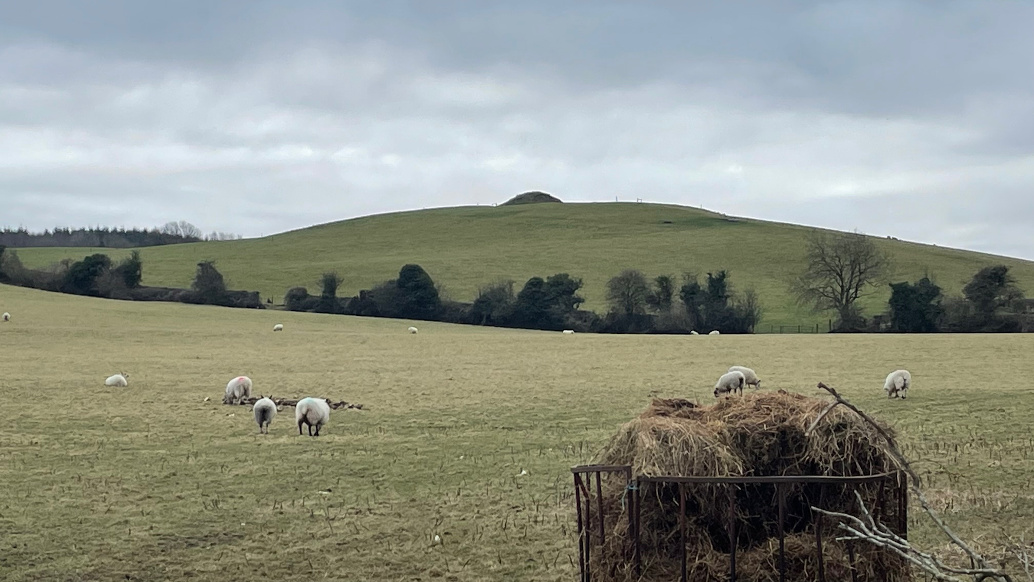




Stone pair, with the kerbstones of Cairn N and the cairn on Carrickbrack in the distance.


The barrows are aligned north-west.south-east.


Bad erosion on the north-west of the largest barrow, with the other prominent barrows over the shoulder to its right.

The tallest and largest of 7 barrows in this cemetery with Thomas for scale.

Middle barrow, about 1.5 metres tall.

The middle barrow to the right and the largest of them all, seeming to slightly mirror the hills in the distance, the Hill of Curry and the Hill of Mael.


The conjoined barrows, with the other two to the left over the shoulder of the left-hand barrow.

The conjoined barrows at the east end of the ‘cemetery’, with Lough Lene off to the right.

The large bowl barrow, again from the north-west, but closer in.

The largest bowl barrow (3.5 metres tall) is visible from the boreen to its north-west.


Small (1.32 metres at its tallest point) mound barrow on the north-west of Knocknamonaster Hill.

The pond barrow on the summit of Knocknamonaster Hill, with the ruins of Fore Abbey behind to the left.

The flat-topped Knocknamonaster Hill behind the trees, seen from the eastern entrance to Fore Abbey.
Gardaí are investigating after graffiti was daubed on the ancient Lia Fail stone on the Hill of Tara earlier this week.
Locals walking the site were appalled to discover the words ‘Fake’ written on all sides of the ‘Stone of Destiny’ or ‘Speaking Stone’ which is believed to be over 5,000 years old.
The incident took place sometime between Monday evening and Tuesday morning. Spray paint was used to damage the stone, said to be a coronation stone for the High Kings of Ireland.
Gardaí in Navan have opened an investigation and are appealing for information. A spokesman said the stone was sprayed with graffiti sometime between Monday evening and Tuesday morning.
More: meathchronicle.ie/2023/02/08/gardai-investigating-after-ancient-hill-of-tara-stone-vandalised/
The National Monuments Service and Office of Public Works (OPW) have confirmed that work on developing a Conservation Management Plan for the Loughcrew site is to commence this year.
Loughcrew cairns, also known as the Hills of the Witch, are a group of Neolithic passage tombs near Oldcastle that are believed to be more than 5,000 years-old and could even pre-date the world heritage site at Newgrange.
Cairn T is one of the largest tombs in the complex and is aligned to sunrise at the spring and autumn equinoxes, when the sun lights up the chamber in a similar phenomenon to Newgrange. It has a cruciform chamber and a corbelled roof with some stunning examples of Neolithic art in Ireland.
However, concerns have been raised for some time over deterioration of the cairn and how best to preserve it.



Shedding new light on the solar illumination in the burial chamber on winter solstice.
Free pdf download of the Winter 2021 article from Archaeology Ireland, Frank Prendergast, Clare Tuffy, Sinéad Gargan, John Lalor and Claire Breen
Council wants structures removed from historic site which was also used for the coronation of early medieval kings
Ciaran O’Neill
December 11 2022 10:27 AM
A long-running dispute over the erection of a wind turbine at a historic site in Co Down has taken a new twist.
The turbine was erected on the top of Knock Iveagh near Rathfriland in 2017. Heritage campaigners were furious planning permission had been granted for the turbine on a 5,000-year-old Neolithic burial site which was also used for the coronation of early medieval kings.
It has now emerged the company which owns the turbine, Ayr Power Ltd, has been served with an enforcement notice by Armagh City, Banbridge and Craigavon Borough Council (ABC) to remove some of the structures associated with the turbine. If the structures are removed, it is understood the turbine would be unable to continue operating.
However, the Sunday Independent has learned Ayr Power Ltd has lodged an appeal against the order with the Planning Appeals Commission.
Papers on prehistoric rock art presented to Stan Beckensall on his 90th birthday
Edited by Paul Frodsham and Kate Sharpe.
Free download.


The massive rath of Teach Cormac looking back towards the King’s Seat and the Lia Fáil.

Standing stone on the southern side of the cairn that contains the tomb.

Outer walling incorporated into the field boundary on the northern side of the tomb.

The small chasm of the gallery is visible to the right of middle of the foreground and is aligned towards the south-west. I think the stone to the left is one of the roofstones.

It looks fairly trashed but is just run-of-the-mill neglected. Stones are: two facade stones and a septal stone in the foreground; a trig point; and two odd outliers.

Front on at this wildly overgrown but largely intact wedge tomb.

Johnny Thornton, the farmer here, was very friendly, though with no clue what he had on his land.


